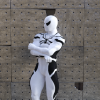What steps are needed to Print 3D Model ???
 Bishop8274
Posts: 1
Bishop8274
Posts: 1
I want to try the 3D printer I won but have no clue where to start. I have had Daz3d for a while and lots of models I would like to print. Thanks.


Comments
google "manifold or water tight mesh" and you'll get lots of info.
I believe that the DAZ Eula allows printing only DAZ original models and not PA ones
So PA items are ok too.
I have listed lots of detailed advice for 3D printing figurines in my blog. As you can see, it isn't simple and there is lots to learn.
Here is a sample from http://3dprintednudes.blogspot.co.uk/2014/03/arch.html
Export the model as an OBJ file keeping the body and hair as separate objects
Import the model into Blender - the hair and body should be separately selectable
Hide the hair temporarily
Select the body and go into point edit mode
Pick any vertex and then use Ctrl-L to select all linked vertices. Now press H to hide these points. This is a really easy way to identify any internal components
Select all of the eyelashes,teeth, gums and tongue and delete them
Keep the front of the eyes but delete the iris, lens and non-visible parts.
Use Alt-H to un-hide any hidden vertices
From the side view, select all the points in the bottom 1-2 mm of the model and scale to zero on the Z axis - this makes a flat base for the model
Now in object mode, hide the body and un-hide the hair
Add a high density icosphere mesh so that it surrounds the hair
Shrink-wrap the sphere around the hair target using the negative projection setting so that all the points move towards the centre until they meet the hair surface
Now delete the hair object and keep the sphere which has taken on the shape of the hair, but in a single closed mesh
Un-hide the body and save the body and hair together as an STL file
Open the STL file in Cura
In the Expert settings, use FixHorrible-Type B - this removes any internal holes and prints much more reliably
Turn on the default support settings
Use Z-lift on retract to stop the nozzle from catching on edges as it travels from area to area
I printed at 0.15 mm resolution with some fairly aggressive cooling from a new fan mounted on the hot-end
Thanks for this!
A very enjoyable read.
Thank you.
Ive been looking everywhere to try and figure out how to fix the hair for printing when I found this. I tried your method on the hair, but it literally looks like I wrapped plastic wrap around the hair so that there is a fill going across the face of the model from the tip of the left bangs to the tip of the right. I kept adding subdivisions but it still comes out extrmely blocky as well.
HeadShop 11 comes with a library of printable hairs that are sculpted for the pupose. https://www.daz3d.com/headshop-11-win
Hi. First, well done for trying and do keep at it. Sounds like you’re missing a step somewhere - I did say it wasn’t simple!
Try these tips:
These steps are just the start of the process. You will still need to smooth, sculpt to add detail as necessary and then Boolean merge the hair and body back together.
Good luck!
It's pretty easy. Use netfabb.com to correct the inevitable problems with your model's topology. Load an OBJ file into the slicer program that came with your printer. You may have to make changes depending on the limitations of your printer. Print. Wait. Enjoy.
The Anycubic Photon 3D is an SLA for less than $300, and produces unbelievable detail.
I strongly recommend you learn how to print already sculpted objects before getting into the nitty gritting of exporting Daz models.
Simply getting an STL file from thingiverse and actually getting a halfway decent print can be quite a challenge depending on your 3d printer.